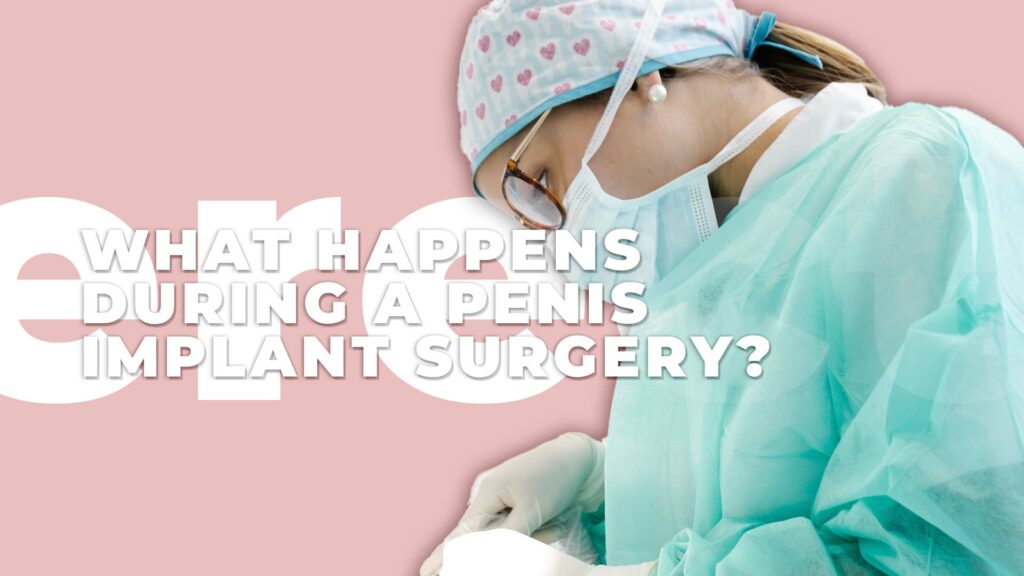Erectile dysfunction (ED) is a medical condition that affects the ability of a man to achieve or maintain an erection for sexual activity. There are various non-surgical treatments available, such as medications, lifestyle changes, and therapy. However, some individuals may opt for surgical solutions when other methods are ineffective. Erectile dysfunction surgery can offer hope to those struggling with severe ED. But it’s essential to understand the costs, options, and potential outcomes associated with these procedures.
Keep reading to find out more about different penile implants, who makes a good candidate, the cost of surgery, and what to expect after surgery.
What is a Penile Implant?
A penile implant, also known as a penile prosthesis, is a medical intervention that can help treat erectile dysfunction (ED).
The procedure involves inserting flexible or inflatable rods into the penis. Inflatable rods require a saline solution-filled device and a pump that is concealed in the scrotum. When the pump is pressed, the saline solution travels to the device and inflates it. This results in an erection. Later, the device can be deflated.
Usually, doctors suggest this surgery for men who have tried other treatments for ED without success. The majority of men who undergo this procedure report satisfaction with the results.
There are various types of penile implants:
- Inflatable Penile Implants
Inflatable penile implants are designed to mimic the natural process of erection. They consist of two inflatable cylinders that are surgically implanted into the penis, a fluid reservoir placed in the abdomen, and a pump located in the scrotum. To achieve an erection, the user squeezes the pump, which transfers fluid from the reservoir to the cylinders, causing the penis to become rigid. After sexual activity, the fluid is pumped back into the reservoir to return the penis to a flaccid state.
- Three-Piece Inflatable Penile Implants
This type of implant is similar to the inflatable penile implant but comes with an additional component—a separate reservoir and a separate pump. The three-piece system allows for a more discreet pump placement and generally provides a more natural erection.
- Malleable (Semi-Rigid) Penile Implants
Malleable penile implants consist of two flexible rods that are surgically placed into the penis. These rods allow the penis to be easily positioned for sexual activity. Unlike inflatable implants, malleable implants keep the penis semi-rigid at all times, allowing for penetration without needing to inflate the implant.
Erectile Dysfunction Surgery Cost and Insurance Coverage
Determining the complete cost of penis implant surgeries depends on various factors, such as the type of surgery and whether you have insurance. According to a 2019 study in Urology Practice, inflatable implants can cost $10,000 to $20,000 without insurance.
This price includes the implant device itself, surgeon fees, hospital or clinic costs, and other fees. While insurance can lower the cost, not all policies cover ED surgeries.
The total cost of the procedure can vary based on several factors, including the
- type of implant,
- location,
- in-network provider availability, and
- your plan’s copays and deductibles.
Medicare is the most common insurer for such surgeries, but it is usually limited to the elderly and disabled. A study shows that 48% of the 127 men who wanted insurance for their ED surgery were denied.
Even with Medicare coverage, certain criteria must be met before the surgery can be covered. For instance, patients need a medical condition that directly causes their sexual dysfunction. They must have also tried other medical treatments that didn’t work.
If you don’t have insurance, your doctor may offer a self-pay plan. It’s important to ask for a cost estimate and contact your insurer before scheduling surgery. Many providers have insurance specialists who can assist with financial matters.
How Does a Penile Implant Surgery Work?
The process of placing an inflatable penile implant involves a healthcare provider surgically inserting two cylinders into the penis, with tubes connected to a reservoir containing fluid under the lower abdominal muscles.
The system also includes a pump located under the scrotum, which inflates the cylinders to the desired hardness level. Pressing a valve on the pump allows the fluid to return to the reservoir, causing the penis to deflate.
With a non-inflatable penile implant, two flexible silicone rods are implanted, eliminating the need for pumping. The implant is used by manually extending the rods, and the hardness does not change even after orgasm. The implant is manually pushed back down after use.
What Happens During a Penis Implant Surgery?

A specialized healthcare team, including a urologist (surgeon), an anesthesiologist, and nurses will perform the surgery.
Before the surgery, you will have a consultation with your urologist to discuss the procedure, the type of implant that’s best for you, and any potential risks or complications. You may also undergo tests to assess your overall health.
The surgery is typically performed under general anesthesia or spinal anesthesia to ensure you are completely numb and comfortable during the procedure.
The surgeon will make a small incision either above the base of the penis or in the scrotum, depending on the type of implant chosen.
Inflatable implants consist of two cylinders that are inserted into the erectile chambers (corpora cavernosa) of the penis. A pump is placed in the scrotum, and a reservoir is implanted elsewhere in the body, usually in the abdomen.
Silicone tubing connects the cylinders to the pump and reservoir. The pump is usually located in the scrotum, allowing you to manually inflate and deflate the implant to achieve an erection.
The surgeon will close the incisions with sutures or surgical staples.
You will typically stay in the hospital for a day or two for observation. Afterward, you will need to avoid sexual activity and heavy lifting for several weeks while the surgical site heals.
Who Should Consider ED Surgery?
If you have persistent ED that is negatively affecting your sex life, and you
- have tried medications for ED (such as sildenafil, tadalafil, vardenafil, or avanafil), or
- have tried a penis pump without success,
penile implant surgery may be a good option for you. This may also be a suitable option if you have a condition like Peyronie’s disease , a history of prostate cancer, or have undergone a prostatectomy.
However, you may not be a good candidate for penile implant surgery if there is a possibility that
- your ED is reversible,
- if your ED is caused by emotional issues, or
- if you lack sexual desire or sensation.
Additionally, if you currently have
- a urinary tract infection (UTI) or
- have inflammation, lesions, or
- other problems with the skin of your penis or scrotum,
penile implant surgery may not be a viable option for you.
How to Prepare for Penile Surgery?
Your physician will conduct a thorough physical examination. Then they will carefully review your medical history to determine if a penile implant is appropriate for you.
The physical exam will entail a comprehensive urologic evaluation. It may include inspecting your genital area and prostate and obtaining a urine sample.
Before considering a penile implant, all other treatment options will be explored. Most physicians will only recommend surgery after you’ve tried less invasive ED treatments, such as oral medications or a penis pump.
Discuss your expectations and concerns with your doctor. You will need to select the type of implant, so inquire about the advantages and disadvantages of each type.
Your physician will also inform you of the risks of penile implant surgery and the necessary follow-up care measures.
Your doctor will likely advise you not to eat or drink anything after a specific time before your surgery. Additionally, you will need to arrange transportation home after the procedure.
How Effective is the Surgery?
A significant number of inflatable penile implant surgeries are considered successful, resulting in firm erections for intercourse. According to a 2015 study, approximately 86% of men who have had this surgery report satisfaction.
Penile implants replicate a natural erection, enabling sexual intercourse. However, they do not enhance the hardness of the head of the penis, nor do they impact sensation or orgasm.
Like any surgical procedure, there is a risk of infection, bleeding, and the development of scar tissue after the surgery. In rare cases, the implant might need to be repaired or taken out if there are problems like mechanical failure, erosion, or adhesion.
Advantages of Penile Surgery
A penile surgery has the primary benefit of providing you with a firm erection that can be maintained for as long as you desire. It does not impact skin sensation, orgasm, or ejaculation.
Additional advantages of a penile implant are:
- Safety: The procedure is generally safe, with a low risk of complications or side effects.
- High success rate: More than 90% of people who undergo penile implant surgery report satisfaction with the results.
- Durability: The lifespan of a new penile implant is around 20 years, making it a long-term solution.
- Outpatient procedure: The surgery typically takes one to two hours to complete, and most patients can return home the same day.
- Increased self-confidence.
Risks or Complications of Penile Surgery
In general, penile surgery is considered to be safe, but it’s important to be aware of some of the risks that may occur. These include:
- Uncontrollable bleeding post-surgery, which may necessitate additional surgery.
- Damage to the urethra that requires surgical repair may delay implant placement.
- Infection that necessitates removal of the implant.
- Formation of excessive scar tissue.
- Erosion or wearing away of skin layers due to the implant.
- Displacement of the pump or reservoir.
- Mechanical failure of the implant.
- Perception of a shorter penis length.
- Reduced blood flow to the head of the penis necessitates implant removal.
Recovery Time After the Surgery

Everyone’s body is unique, so healing times may differ among individuals. In general, pain, swelling, and discomfort should decrease within a week, while tenderness can persist for up to six weeks.
Your healthcare provider may prescribe antibiotics, pain relievers, or other medications. These should be taken as directed.
To manage pain, some people take nonsteroidal anti-inflammatory drugs (NSAIDs), such as aspirin, ibuprofen, or naproxen. These can be bought over the counter. However, not everyone can take NSAIDs, so consult with your doctor for other suitable medications.
To prevent infection and promote healing, gently clean and dry the affected areas regularly. Before changing your bandages, wash your hands with soap and water, and remember to wash your hands before using the restroom.
You can also use an ice pack to reduce pain and swelling, applying it to the affected areas for up to 10 minutes and repeating this throughout the day.
While recovering, it’s crucial to avoid heavy lifting and strenuous exercises that could exert pressure on your incisions.
Do Penile Implants Make You Bigger?
Penile implants do not enlarge your penis beyond its size before the surgery. In fact, your erect penis may seem shorter than it used to be before the surgery.
Note that the implant is not in the head of your penis (glans), so the head of your penis will not get hard. This can make it appear smaller than before. Your healthcare provider may prescribe medication to help improve blood flow to the head of your penis.
Newer penile implant models may slightly increase the length, thickness, and rigidity of your penis due to the cylinders. However, this change may occur gradually over time as you use the device.
How Long Do Penile Implants Last?
Penile implants usually last for a period of 15 to 20 years in most men. Note that implants are mechanical devices that can potentially malfunction or break over time. However, such occurrences are rare, and they can be corrected with a brief surgical procedure.
Is Penile Implant Surgery Painful?
After the surgery, you may experience mild to moderate discomfort for a few days, but the symptoms usually resolve within one to two weeks.
As the procedure is performed in a sensitive area, there is some soreness after the procedure. However, measures such as draining accumulated fluid, prescribing pain relief medication, and using compressive surgical dressings are used to minimize discomfort.
Recovery time varies depending on several factors. Your healthcare provider will advise you when you are ready to resume sexual activity.
When Can You Have Sex or Masturbate after Surgery?
Your surgeon will give you instructions on when it is safe to masturbate or have sex after your surgery. These instructions will depend on the type of surgery you had. As a general rule, it is recommended to avoid sexual activity for at least four weeks after penile surgery.
When Should You Call A Doctor?
After getting a penile implant, it’s important to schedule regular check-ups with your doctor. If you have a surgical drain, it will typically be removed within one to three days after the surgery. Around four to six weeks after the procedure, you should see a healthcare provider to learn how to properly use your penile implant.
If you have problems after the surgery, call your doctor right away. These complications may include
- heavy bleeding at your incision sites,
- a fever of 100 degrees Fahrenheit (38 degrees Celsius) or higher,
- infection of the surgical incision, and
- increased pain.
Alternatives Treatments for Erectile Dysfunction

There are several treatments available for erectile dysfunction (ED). One of the most common treatments is medication, with cheaper generic versions now available. However, medication can cause side effects. Certain medications or cardiovascular conditions may also prevent its use.
Another treatment option is a penis pump, also known as a vacuum pump, which can be effective for those with moderate ED. The pump removes air from a tube that is placed over the penis, creating a change in air pressure that causes blood flow to the penis and an erection.
Penis injections are also an option for ED treatment. The medication is injected into the penis, and an erection typically occurs within 5 to 15 minutes. This treatment can be effective, but some people experience side effects and dislike injections.
Lifestyle changes, such as quitting smoking and managing stress, can also be effective in treating ED. These changes are often free or inexpensive and can improve overall wellness.
Talk therapy may be recommended before penile implants. This therapy is particularly useful if the ED has an emotional root cause such as stress, anxiety, or trauma. While talk therapy can be expensive, it may be cheaper than penile implants and can improve mental health more generally. However, it may not be effective if the ED is not a symptom of a larger emotional problem.
Final Words
When it comes to treating ED, there are various alternatives that one can consider. It’s crucial to approach surgery with caution, regardless of the reason. A urologist can help decide the best treatment for you based on your medical history and current condition. Typically, they recommend exploring PDE5 inhibitors before considering surgery as an option.
References
- Masterson JM, Kava B, Ramasamy R. Commercial Insurance Coverage for Inflatable Penile Prosthesis at a Tertiary Care Center. Urol Pract. 2019 May;6(3):155-158. doi: 10.1016/j.urpr.2018.07.002. PMID: 31372371; PMCID: PMC6675033. https://www.auajournals.org/doi/10.1016/j.urpr.2018.07.002
- Peyronies Disease https://www.urologyhealth.org/urology-a-z/p/peyronies-disease
- Ji YS, Ko YH, Song PH, Moon KH. Long-term survival and patient satisfaction with inflatable penile prosthesis for the treatment of erectile dysfunction. Korean J Urol. 2015 Jun;56(6):461-5. doi: 10.4111/kju.2015.56.6.461. Epub 2015 Jun 2. PMID: 26078844; PMCID: PMC4462637. https://icurology.org/DOIx.php?id=10.4111/kju.2015.56.6.461
- C. Bettocchi, P. Ditonno, F. Palumbo, G. Lucarelli, G. Garaffa, B. Giammusso, M. Battaglia, “Penile Prosthesis: What Should We Do about Complications?”, Advances in Urology, vol. 2008, Article ID 573560, 5 pages, 2008. https://doi.org/10.1155/2008/573560










Leave a reply